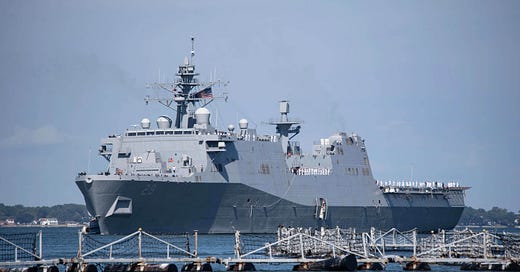The urgent imperative for naval strategy reform
Dear colleagues,
I'm pleased to share with you a fine article by Kelley Vlahos in the journal Responsible Statecraft that carries some of my thoughts on crucial reforms that are necessary in U.S. Navy strategy. She notes my observation that Chinese strategists are well aware of the vulnerability of American logistics nodes that stretch across the enormous Asia-Pacific region—a factor that impacts the other services too—but could prove devastating for the U.S. Navy in a Taiwan or South China Sea contingency. At the end, the article also cites my critique of current strategy, which I view as continuing a pattern of needless overstretch on the force that is wearing out hulls, pushing crews to the limit, and expending scarce resources on unnecessary missions like parading around insignificant "reefs and rocks."
I advise that we do not need the largest navy on the planet, but we do need a competent and lethal maritime force. Let me add here that I'm very far from convinced that the U.S. Navy and national leadership have truly grappled with the endemic strategic failures that led in 2017 to the deaths of 17 American sailors in two tragic collisions that both occurred in the western Pacific. It is well past time for a bottom-up review of American naval strategy. We can afford a top-tier naval force with both outstanding warships and proficient mariners, but we must reign in our objectives substantially—and that means making the conscious choice not to play "globo-cop," but instead to focus on national interests and genuine national security imperatives.
Photo: Navy Petty Officer 1st Class Sophie A. Pinkham / DoD
Disabled refueler exposes fragility of U.S. mission in Middle East
Lyle Goldstein, who studies both Russian and Chinese militaries, said there are widespread issues confronting the U.S. Navy right now and the grounding of Big Horn “certainly illustrates this.”
He said there are similar issues with stretched oilers operating under the U.S. Pacific Fleet, which includes the 3rd and 7th Fleets, for a total of 200 ships, 1,500 aircraft, and 150,000 military and civilian personnel. “I have documents illustrating that Chinese strategists repeatedly identify weaknesses in the U.S. Navy logistics system stretching across the Asia-Pacific, particularly with respect to oilers,” he told RS.
Like other strategists he believes that the current capacity no longer matches the ambitions of the U.S. to be everywhere, all the time, and to engage in aggressive posturing in places like the Pacific while literally fighting a military upstart (Houthis) in the Middle East. American ships, along with the UK Royal Navy, have been intercepting and engaging Houthi attacks for almost a year. Critics say the kinetic mission is expensive and futile, and ultimately not in U.S. strategic interests.
On the Middle East, Goldstein said, “to me it is quite a dicey situation and may imply the need for a rethink of strategy across the board, including Naval strategy where clearly the force is over-taxed and there needs to be a readjustment and retrenchment. People should realize that we don’t need the largest Navy on Earth, but we need a competent Navy. And we will only have a more competent Navy if we rein in our objectives, train our crews closer to home, prioritize our people, and re-focus on warfighting competencies versus parading around to demonstrate 'presence."



